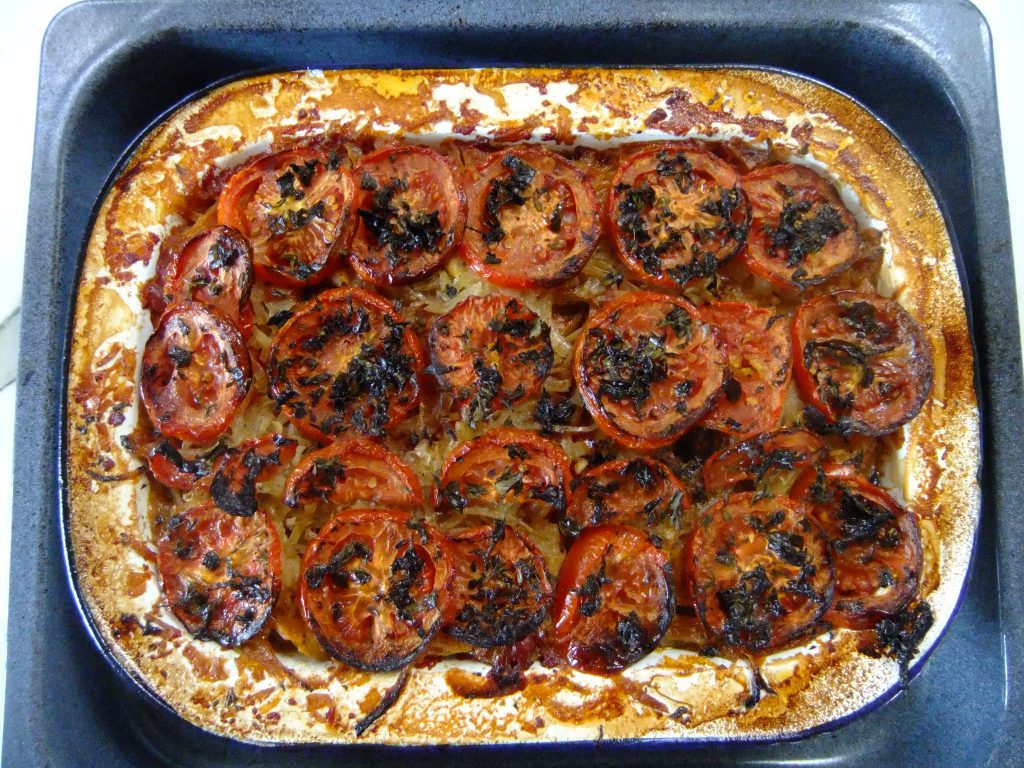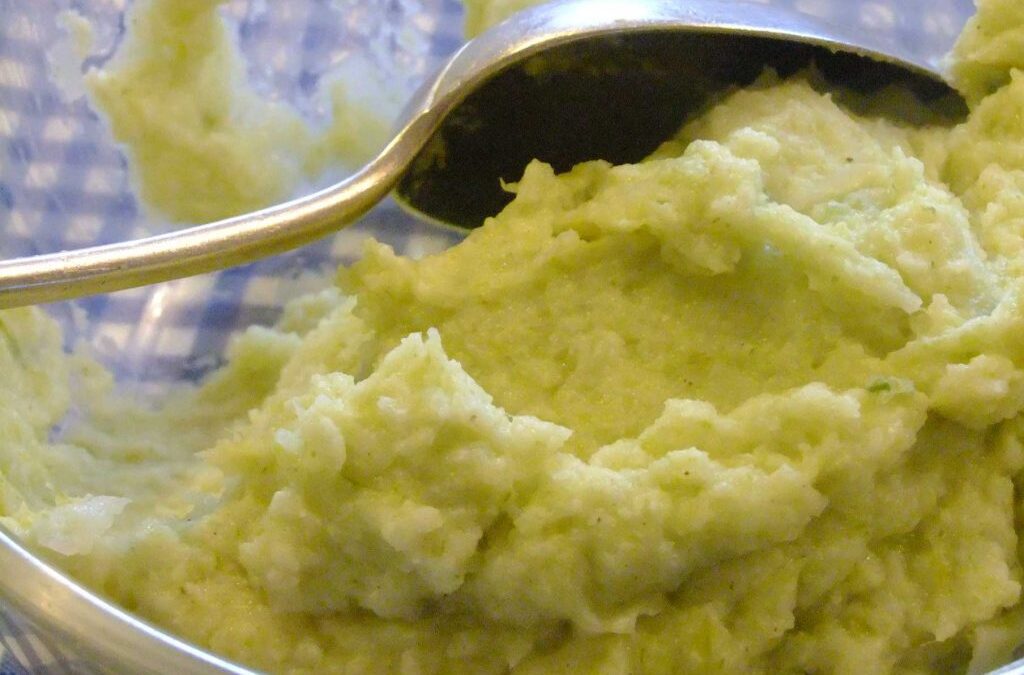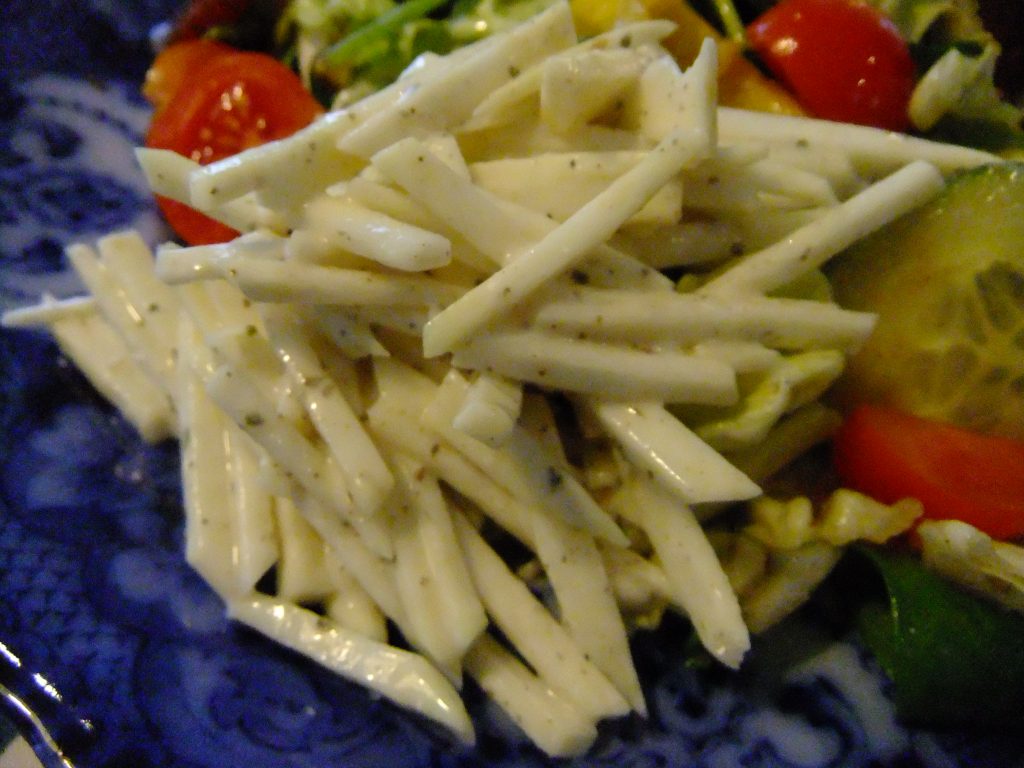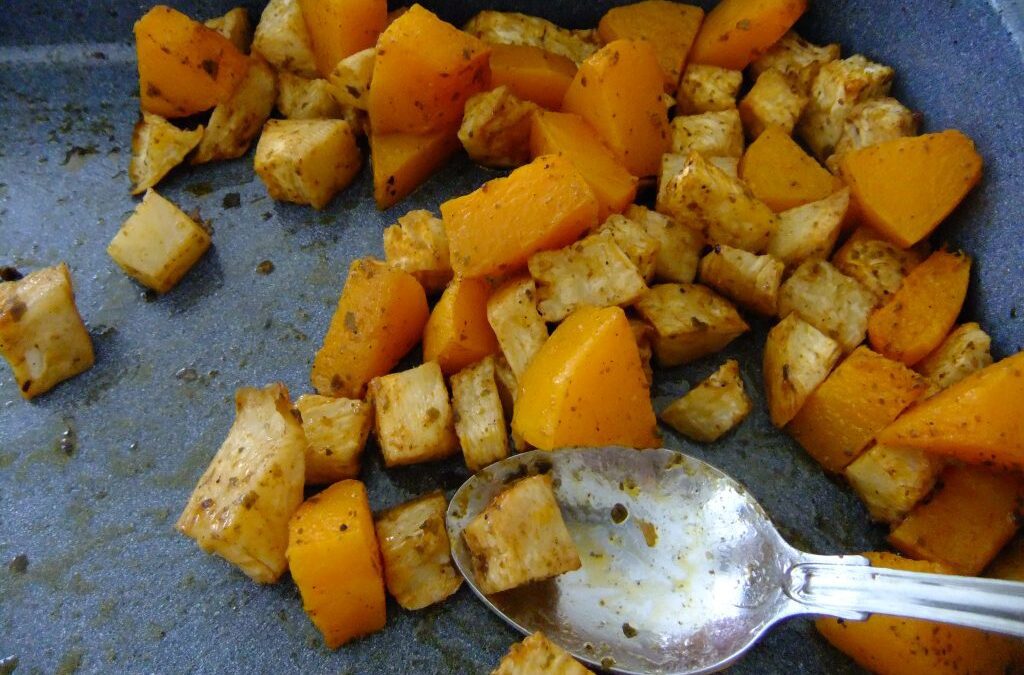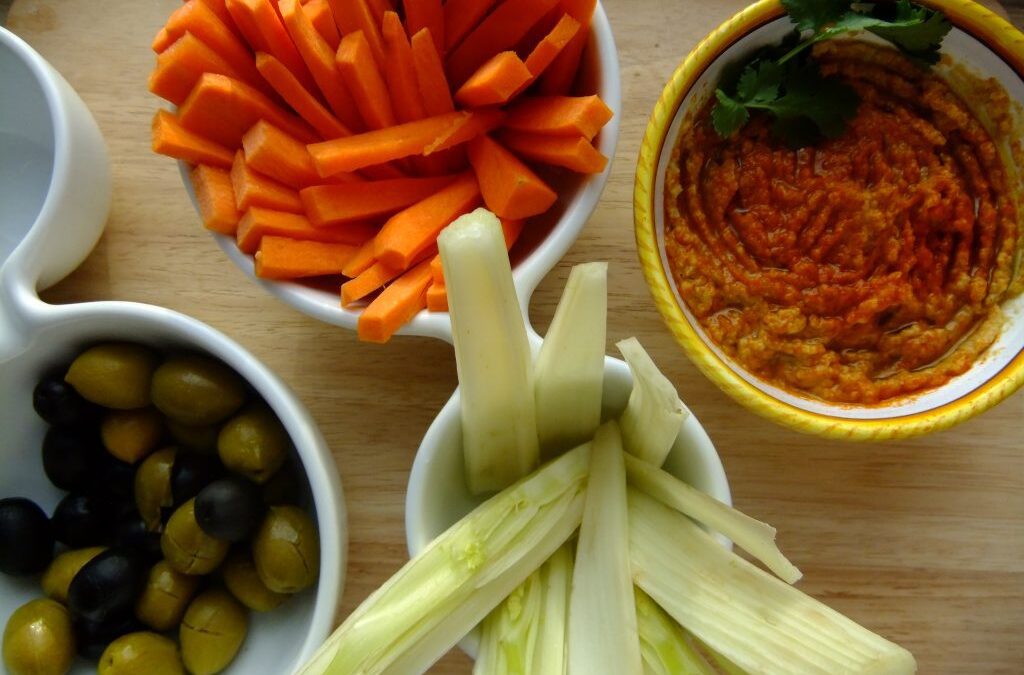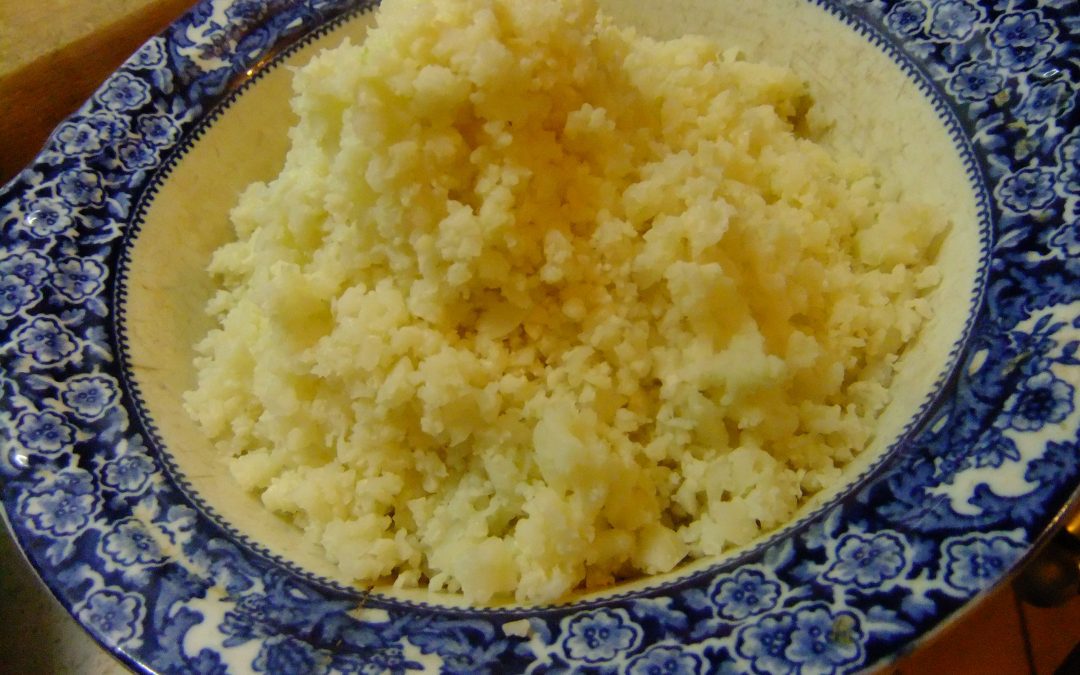
Sep 12, 2016 | Anna's Best Recipes, Main courses, Packed lunches, Sides, starters, soups & snacks

Bleck-eyed beans with sweet potato and coriander
This is real comfort food and a great crossover dish for feeding vegetarians and carnivores at the same dinner table. It’s pretty rich in protein do if you are feeding a vegetarian its a good choice. But you can also serve it as an accompaniment to roast or grilled meat or fish. I love to eat it as a vegetarian dinner with just a simple green salad or some steamed green/runner beans drizzled with olive oil and paprika. The recipe was I think from Cafe Paradiso but I changed the recipe a bit to use non-toxic oils. Hope you enjoy it. It also works great as a salad in a box to take to work or school.
For 6 as an accompaniment or 3 as a main course
2 medium-sized sweet potatoes, peeled
1 large bunch coriander, stalks and all, chopped
400g dried black-eyed beans (health stores/most supermarkets) soaked in boiling water for 45 minutes
or
2 cans of tinned black eyed beans, drained and rinsed
2 tbs extra virgin oive oil (1 dsp for cooking and 3 dsp for mixing in at the end)
2 large red onions, peeled and sliced or chopped
1½ heaped tsp cumin seeds (the Asia Market good for inexpensive spices)
3 large cloves garlic, peeled and finely chopped
1½ tbs lime juice
¼ tsp Himalayan salt or Atlantic sea salt
1. If using dried beans (and not tinned) , drain the soaked beans and put them into a large pot, adding enough boiling water to cover the beans by a few centimetres, and bring to the boil. Skim off any foam that comes to the surface and cook on a gentle boil for at least 45 mins. Top up with more hot water if it reduces too much. Test the beans to see if they’re cooked and continue until they’re done, when they should be drained, reserving the stock. If using tinned beans, rinse and drain well.
2. Dice the sweet potatoes into ½”/1 cm cubes. Then steam until the point of a knife goes in easily but they are not mushy. Drain carefully and keep the liquid.
3. Place 1 dsp olive oil and 1 dsp water in a large heavy bottomed saucepan, add the onion and cumin and sweat (covered) on a medium heat, stirring occasionally, until the onions are translucent. Add the garlic and cook for another 2 mins. Add the lime juice, bring to the boil, then remove from the heat. Gently mix in the sweet potato, beans, the rest of the olive oil (1½ tbs), coriander, ¼ teaspoon salt, plenty of freshly ground black pepper and ideally leave sit for an hour before serving. This intensifies the flavours.
Why this is good for you:
Extra virgin olive oil, is good for heart health. It contains anti-inflammatory vitamin E, polyphenols and a whole host of other compounds shown to boost our health and vitality. Coriander helps sooth your digestive system and also helps reduce numbers of “bad” bacteria in your digestive system. Too many unhelpful types of bacteria in your gut can cause acne, digestive disorders and even anxiety states and low mood.
Beans are a rich source of magnesium, deficiency of which is linked to stress, constipation, insomnia, anxiety and difficulties with skin health. Refined foods (sugar/white grains), alcohol, stimulants and smoking rob you of magnesium.

Aug 31, 2016 | Anna's Best Recipes, Main courses, Sides, starters, soups & snacks
This is delicious hot, lukewarm or cold. I also like to mix leftovers with cooked quinoa to take to work. People living on the Greek island of Ikaria have the secret of healthy longevity. This is one of their recipes, which I found in the Irish Times recently. We can’t get giant white beans here but butter beans work really well. I wasn’t sure it would turn out well, but it was delicious – very intense flavours. It contains a lot of liquid. So make sure to use a large dish, otherwise it can boil over in the oven (like it did on me). Slicing the carrots very thinly is a bit of a fiddly chore unless you use a mandolin or a food processor. If you can’t face it or don’t own a decent knife: slice about 1/2 cm thick, steam for a few minutes to soften (keeping the water to make the veg stock with so you don’t lose flavour or nutrients). If you put thick sliced raw carrots into the dish they will still be raw when everything else is starting to burn! Yummy though. This also works well as a side dish with, say, roast lamb.
For 4:
6 tbsp extra virgin olive oil
1 x 640g jar of passata (sieved tomatoes)
2 x 400g tins butter beans, drained (or soak 400g or 2 cups dried beans overnight and boil till tender)
3 onions, finely sliced
4 garlic cloves, finely sliced
4 carrots, thinly sliced
2 large beef (or 4 regular) tomatoes, sliced
A good handful of fresh oregano (if you can’t get it, use 1 dsp dried)
A few sprigs of thyme
2 bay leaves
300ml vegetable stock
Sea salt and ground black pepper
- Preheat an oven to 220 degrees (205C fan).
- Add the onions and garlic to a bowl with four tablespoons of olive oil. Season with sea salt and ground black pepper. Massage the onions until they begin to soften down.
- Arrange the butter beans in the base of a large earthenware or baking dish. Place carrots on top.
- Pour over the passata and spread evenly. Arrange the onion mixture across the top, then the tomato slices and press the herbs on top.
- Pour over the vegetable stock, drizzle on the remaining oil and season. Bake on the middle shelf for 40 minutes or until the point of a knife or cooking skewer goes through the carrots easily.
Serve warm, lukewarm or cool with a green salad on the side. You can use leftovers as an accompaniment to grilled or baked white fish. Or (provided you’re not on SC Diet) stir into cooked quinoa to make a quick lunch (or packed lunch).
Why this is good for you:
Butter beans, onions and garlic give you soluble fibre which feeds good gut bacteria needed to help you get rid of toxins, have happier mood (yes, gut bacteria make the feel-good brain chemical serotonin!) and a healthier immune system. A healthy immune system is one that doesn’t over react causing autoimmunity (e.g. rheumatoid arthritis, hypothyroidism). Nor does it under react causing lowered resistence to viral, bacterial or fungal infections. Lycopene in tomatoes is fantastic for supporting vision and so are carrots with their various carotenoids. Lycopene and carotenoids are antioxidants – they protect you from damage.

May 11, 2016 | Anna's Best Recipes, Sides, starters, soups & snacks

Aubergine mint feta and sundried tomato bites
I concocted these delicious salty, minty, meaty bites recently. Great for providing some soakage with a glass of wine before a nice dinner (helps you avoid the sugar rush from the wine). The combination of mint and grilled aubergine gives a Middle Eastern feel, I think. do try to get true feta (made from goat or sheep milk, not cow). It has a better flavour and is easier to digest.
Makes about 20
1 very large or 2 medium aubergines, sliced lengthways into 1cm thick slices
1 tsp ground coriander
A few sprigs fresh mint
Half a block of goat or sheep feta cheese
5 sun dried (or semi sun dried) tomatoes marinated in oil, each cut in quarters or sixths
Freshly ground black pepper
To secure: cocktail sticks or around 20 long chives
1. Arrange the aubergine slices on a grill and sprinkle with ground coriander. Grill under a medium heat until golden, turn and continue cooking until softened. These will keep for several days in the fridge or until you are ready to assemble the bites.
2. Slice the long aubergine pieces crossways into 4cm wide strips. Onto each piece of aubergine put a piece of sun-dried tomato and a piece of torn mint leaf.
3. Give everything a good grind of black pepper. Roll the aubergine up with the mint and tomato inside. Secure with a cocktail stick or if you are feeling super-fancy, tie with a chive, knotted to hold everything together.
Why these are better for you
Did you know that goat and sheep cheese are easier for many of us to digest than cow cheese? This is because they contain less of the hard-to-digest casein protein than cow milk products do. Any cheese with a tangy taste has also undergone some fermentation, converting the lactose (milk sugar) into lactic acid. This means that they are not a problem for people who can’t digest lactose. If you have taken antibiotics, have an inflammatory bowel condition or have digestive or skin issues you could be low in beneficial bacteria like lactobacillus. This impairs your ability to digest lactose. Mint and peppermint can help reduce levels of bad bacteria (that’s why they are in toothpaste!) but support growth of good bugs. This can be really helpful for making your digestive system more comfortable after a meal. Coriander is anti-inflammatory, anti-ageing as well as being delicious. Caution: don’t cram in tons of sundried tomatoes or feta every day because these are very high in table salt. Table salt is an industrial product with added aluminium to keep it from clumping – this makes it not very good for us. For adding to food, Atlantic sea salt or Himalayan salt is a better choice as it contains other minerals besides sodium. Eating protein with your glass of wine instead of high carb snacks like crisps or bread sticks means you don’t get a sugar rush (very damaging to all your body tissues, including a leading cause of wrinkles!!).

Mar 8, 2016 | Anna's Best Recipes, Sides, starters, soups & snacks
I like to cook this to go with a fish, meat or vegetarian curry. This is great with the butterbean curry I posted recently, or any Indian fish, meat or lentil curry. I adapted this recipe from “The classic 1000 Indian recipes” switching to coconut oil instead of polyunsaturated vegetable oil. I love to have a popadom or two with this – buy them raw for a few cents in your local Indian shop and microwave individually on high for 1 minute. I’m not a fan of microwaves but when the alternative is deep frying and it’s only once in a while, what the hell…
You will need a mini food processor (or old-fashined mouli-legume) to blend the spinach into a puree.
For 4
500g spinach leaves, washed
2 level tbs virgin coconut oil (or butter or ghee)
3 large garlic cloves, crushed or finely chopped
4cm ginger root, peeled and finely chopped or grated
1 large onion, finely chopped
1 rounded tsp garam masala
1 rounded tsp ground cumin
½ tsp ground turmeric
½ tsp ground red chilli (optional)
1 cup water leftover from steaming veg, or use plain water
Himalayan or Atlantic sea salt
1. Place the spinach in a steamer, cover and steam for a few minutes until wilted. Blend to a puree in the food processor.
2. Heat the coconut oil in a heavy-based pan and sweat the onion, ginger and garlic with 1 tbs water over a medium heat until softened and translucent but not brown. Sweating involves using a gentle heat and covering the pan with a lid or plate so the steam cooks it.
3. Stir in the ground spices and a pinch of Himalayan/Atlantic sea salt.
4. Mix in the blended spinach and heat through, stirring, for a few minutes.
Serve with:
My butterbean curry or a meat/fish curry.
Darnes of salmon you have dusted with (gluten-free) curry powder and grilled (allow about 5-6 mins flesh side up then turn and grill skin side up for 1-2 mins).
Why this is good for you
Herbs and spices have fantastic health benefits. From helping blood flow to your brain to inhibiting inflammation. Chilli is clinically proven to heal stomach ulcers. ginger is anti-inflammatory especially in the digestive system, where it soothes inflamed membranes. Turmeric aids liver function and quells inflammatory conditions in the skin, joints and more. What’s not to like as they also make meals SO much more exciting. Not just fresh but dried herbs and spices have benefits provided you keep them in airtight containers away from sunlight. Like all dark green leafy vegetables, spinach is a rich source of folic acid and magnesium. Folic acid helps your digestive system carry out essential repairs and maintenance every day while magnesium is essential for liver function, healthy skin, stress reduction and sleep.

Feb 17, 2016 | Anna's Best Recipes, Sides, starters, soups & snacks
This mash is a fantastic substitute for mashed potato. I love it because contains more nutrients and much less (natural) sugar and is still delicious. All the comfort of regular mash, none of the downside.
1 small head cauliflower, separated into florets
1 leek, white (and 6cm of green if you like), well washed, cut into 1cm slices
1 knob (about the size of a walnut in its shell) of organic ghee (for people with dairy protein tolerance) or butter or 1 dsp extra v olive oil
2 tbs of unsweetened additive-free non dairy milk like coconut or almond or (if you can eat dairy) you can substitute regular milk or cream
Pinch of ground nutmeg (optional)
¼ tsp freshly ground black or white pepper plus pinch of Himalayan salt/sea salt
1. Steam the cauliflower until softened, then throw the leek in on top and steam everything until very soft. Drain well.
2. Place the vegetables with the milk, ghee/butter and seasonings in the food processor and blitz for a few minutes until smooth. It will have some flecks of green thorough it and look like potato mash.
Tip:
Make lots and store leftovers in the freezer. Reheat over a gentle heat, stirring.
Variation:
Add 2 good tablespoons of chopped parsley when blitzing.
Why this is good for you:
First of all you are getting sulphur from brassica and onion family veg (cauli and leek). This helps your detoxification. Leeks also contain prebiotic fibre which turbo-charges growth of certain good gut bacteria to keep you well. There’s also the major benefit of this mash being much lower in carbohydrates (sugars) than potato mash. Potatoes, especially peeled and mashed are massively high in (natural) sugars which promote blood sugar imbalances when you eat large amounts. Meals very high in carbohydrates slow down our detoxification. Also, because they are satiating, they prevent us from eating lots more vitality-boosting green and non-starchy vegetables in a meal. A seemingly healthy meal of say potatoes, carrots, parsnips and meat is in fact a large sugar overload because the veg are all root vegetables and therefore rich in sugars. Potatoes contain much more sugar than other root veg like carrots. A much more health-supporting combination would be 25% meat, up to 25% starchy carbs (e.g. carrots, potatoes, parsnips, turnips) and 50% or more non starchy vegetables (e.g. green vegetables, cauliflower).

Nov 12, 2015 | Anna's Best Recipes, Dressings, rubs, spreads, sauces & more, Sides, starters, soups & snacks
Try this as a side instead of potatoes with some grilled fish and green veg. We had it last weekend with gorgeous meaty (nitrite-free) sausages and steamed broccoli drizzled with extra virgin olive oil. The sausages came from Coolaknowle Organic Meats https://organicmeat.ie/ at the Green door Market in Dublin on Fridays and Saturdays. All their meats are fantastic quality and none contain nitrites. They also do a really good gluten-free sausage that’s high meat content and of course, also nitrite-free. I LOVE the Green Door Market – so many fantastic food producers under one roof. Saturday is THE best day https://www.thegreendoor.ie/
For 4 servings:
One small celeriac
2 tbs thick homemade kefir, natural yoghurt (if you are on the SC diet, the kefir or natural yoghurt need to be home-made) or creme fraiche
Juice of half a lemon
2 dsp Dijon mustard
Plenty of freshly ground black pepper
A pinch of Himalayan/Atlantic sea salt
1. Peel the celeriac (you’ll need to cut off anything knobbly).
2. Coarsely grate or cut into thin batons (about 2mm thick) or julienne strips (you could also use a spiraliser and use the “noodle” attachment).
2. Combine with all the other ingredients and mix well.
Serving idea:
Drape with smoked salmon and serve with a mixed salad.
Why this is better for you
Celeriac is lower in carbohydrates (sugars) than potatoes so it’s a much healthier choice for anyone who cares about their waistline, their digestive health or their ability to look younger for longer. Mustard helps reduce inflammation. An interesting recent study showed a marked improvement in eczema when mustard was added to the diet of mice with the inflammatory skin condition. And of course celeriac is free of disaccharides, the sugars that anyone with active Crohn’s or ulcerative colitis cannot digest.

Oct 30, 2015 | Anna's Best Recipes, Sides, starters, soups & snacks
These aren’t fried at all but taste just as delicious. This simple side is good with green veg and some grilled/roasted fish, or roasted meats but it would also be nice with a vegetarian bean stew. You can use pumpkin instead of the squash if you like. I like to add leftovers of this dish to my lunchtime salad the next day.
The recipe is in Raman Prasad’s “Recipes for the Specific Carbohydrate Diet“. As know from my last blog, this diet can be a real lifesaver for people with serious intestinal inflammation (Crohn’s or Colitis). The diet often gets them into a much better state so they can work on the root causes of their condition and move towards staying symptom-free.
For 4-6 servings
1 butternut squash (or small pumpkin)
1 large celeriac
3 tbs (45ml) extra virgin olive oil
Lots of freshly ground black pepper1/2 tsp Himalayan/Atlantic sea salt
One or all of the following if you have them:
1 dsp dried oregano, 1 teaspoon paprika or 2 dsp fresh thyme leaves
1. Preheat (fan) oven to 180C (195 for non-fan).
2. Peel the squash, cut in half, and scoop out the inside seeds. chop into 1.5cm dice. Peel the celeriac and cut into similarly sized cubes.
3. Tip the veg into a large baking tray, sprinkle on the salt, pepper (and herbs/spices if using) and the olive oil. Toss everything well with your hands until everything is well coated.
4. Bake for 30-40 minutes, turning once to ensure they cook evenly.
Why this is good for you:
These veggies are higher in fibre and lower in sugars than potatoes so they are a healthier choice. Orange veg are high in beta carotene, important for skin health and for keeping your digestive system in tip top condition. Unlike potatoes and grains, these are much less likely to irritate an already inflamed digestive system. Because they are starchy carbs (i.e. high in natural sugars) these are not suitable for eating on their own but need protein (e.g. fish, eggs, beans, meat) and green veg alongside for a balanced meal.

Apr 30, 2015 | Anna's Best Recipes, Dressings, rubs, spreads, sauces & more, Sides, starters, soups & snacks

Middle Eastern tahini dip with crudites
This is based on a Sophie Grigson recipe I loved, but lost. My husband says this version is the best of my attempts to recreate it. It’s dead simple. Enjoy with strips of red pepper, carrot, cucumber or celery and maybe a few olives. Dips with veg sticks before a main course are a great way of encouraging your kids to eat veggies too – take advantage of them being hungry!!
For a smoother dip use normal tahini made from roasted sesame seeds. For a coarser (and even more vitality boosting) dip use raw tahini (e.g. Carly’s) from health shops. Raw seeds retain their beneficial oils to do your body even more good. If you’re not going to use this dip within half an hour or so, store in a small screwtop glass jar or else a small glass/ceramic container with clingfilm over the top (but not in contact with the dip itself) to stop it drying out.
To make this dip into a sauce add a little more water to thin and drizzle over cooked white fish or felafels.
To serve 3-4 as a starter
2 cloves garlic
2 level tbs dark tahini
1 1/2 tbs lemon juice
1 dsp extra virgin olive oil
1 level tsp cumin
Pinch Himalayan or Atlantic sea salt
Pinch cayenne pepper
4 tbs water
Mini food processor method:
1. Crush the garlic and throw it and the rest of the ingredients into a mini food processor.
2. Blend for a couple of minutes, scraping down the sides of the processor a few times to get everything well mixed.
3. If you have time, allow to sit for half an hour for the flavours to amalgamate.
Traditional method:
1. Crush the garlic and place in a mixing bowl with everything except the water.
2. Mix well with a wooden spoon, then add half the water. The tahini will become quite stiff at this point, just keep mixing and it will start to relax and absorb the water.
3. Mix well, then add the rest of the water and work till smooth. This will be a more rustic mix than using the food processor. If you have time, allow to sit for half an hour for the flavours to amalgamate.
NB. If you are on a ketogenic eating plan, avoid eating more than 1/2 cup raw carrots in the day. Like all root veg, they are rich in sugar and too many will derail your programme.
Why this is good for you:
Garlic is a fantastic booster for your whole body. It kills yeast infections and overgrowths of pathogenic (“bad”) bacteria in your gut. This is good news if you want to sort out your digestion or achieve beautiful skin. Garlic’s sulphur compounds also support your liver to clear chemicals, used-up hormones and other toxins out of your body. Skin conditions are usually largely due to problems in the digestive system. Sort those out and you have dont more than 90% what you need to do. If you are not used to eating garlic, especially raw garlic, start with a little and gradually build up. Garlic is in my top 10 vitality boosting foods. Spices like cumin and cayenne pepper also have great benefits – anti inflammatory, anti-ageing and more. Have you had your spices today?

Apr 22, 2015 | Anna's Best Recipes, Sides, starters, soups & snacks
If you like both Thai food and Spanish gazpacho you will love this recipe by Domini Kemp. I think it’s fantastic. Have it as a filling snack, as a starter or with some chicken or fish and a little green salad for a main meal. If you don’t like cold soups, then this can be heated very gently until only just lukewarm.
For 4-6 servings
For the soup:
400ml tin full fat coconut milk (go for organic from health shops – free from chemical emulsifiers and BPA in tin linings)
1 large ripe avocado
2 large tomatoes, cut into rough chunks
2 large cloves garlic, peeled and crushed
Big knob ginger
1 large tbs (25g) non-gmo miso paste from a jar or vacuum pack (if you are gluten-free then brown rice miso is best, or hatcho miso)
Juice of 2 limes and 2 lemons
1 courgette, sliced
1 red chilli, de-seeded and sliced
Big bunch each coriander and basil
1 tbsp Thai fish sauce
Black pepper to taste
For garnish:
1 red onion, very finely chopped
Fresh coriander
- Blitz everything except the garnish ingredients in a liquidiser or food processor to form a smooth soup.
- Pour into bowls and sprinkle the finely chopped red onion and coriander on top.
Why this is great for you
The raw miso in this soup is packed with beneficial bacteria so important for your skin, digestion and even your mood. Heating above 45C would destroy these good bacteria so the fact the soup is raw is brilliant. Beneficial bacteria help your body to clear used-up hormones such as testosterone and oestrogens, help repair your intestines and make digestive enzymes and even control your mood and how your skin looks. Coriander, lemon, lime and garlic actively help your liver and gut clear normal (and abnormal) toxins out of your body. In our chemical-laden modern world, this is good news. Coconut milk contains capryllic acid, which, like raw garlic, helps to kill off excessive pathogenic yeasts (eg candida albicans). Fresh coriander also binds to heavy metals (like mercury from dental fillings) and escorts them safely out of your body via your bowel.

Mar 26, 2015 | Anna's Best Recipes, Sides, starters, soups & snacks
You’ll already know my recipe for creamy cauliflower mash from this blog but I’m discovering even more ways to use this versatile vegetable. My latest discovery is cauliflower “rice”. It’s really simple to make and only takes 5 minutes to cook. We substitute it for rice with our curries and chillies. Yum – and you don’t feel drowsy afterwards. You can rice lots of cauliflower at the same time and store it uncooked in self seal bags/airtight containers in the freezer. To use, simply empty into the steamer (no need to thaw, just break it up with your hands) and steam away. As the title implies, broccoli works just as well for making “rice”. You can even buy frozen broccoli rice in some supermarkets.
There are two methods for cooking this. One using a steamer, one using a pan.
For 4 large servings (steamed version)
1 head cauliflower (about 750g)
Freshly ground black pepper
A pinch of Atlantic sea salt/Himalayan salt
Small knob (level tsp) virgin coconut oil or a splash of extra virgin olive oil
You will also need a food processor and a steamer or pan.
- Break the cauliflower into large florets and discard the large stalks (any more than around 2cm thick).
- In the food processor, pulse until the cauliflower particles are the size of grains of rice.
- Steamer version:
Place in a steamer over boiling water. Steam for 3-4 minutes until softened. Drain well, stir in the oil and pinch of salt.
Frying-pan version (richer, more flavoursome):
Follow steps 1-2 then heat a frying pan or heavy bottomed saucepan on a medium heat.
Add a teaspoon of virgin coconut oil, avocado oil or extra virgin olive oil and a splash of water (around 1 tbs). Cook for 3-4 minutes, stirring often (otherwise it sticks and burns). If its too dry and is catching add a little more water.
Why this is amazing for you:
The advantage of cauliflower over rice is cauliflower doesn’t flood your body with more carbohydrates than you need. Carbohydrates are foods made up mostly of sugars. Potatoes, grains (even wholegrains!), fruit juices, certain fruits and of course sugar and honey are all high carbohydrate foods. Switching to a moderate or low carbohydrate eating style is particularly useful if you want to resolve digestive problems or skin issues. High carbohydrate eating styles make every health condition worse. Reducing your carbohydrate foods can even slow or stop hair loss. A good guideline for a moderate carbohydrate diet is for bread, potatoes, rice or pasta to make up no more than ¼ of your plate at lunch and your evening meal. Cauliflower is not high in carbohydrates so makes a brilliant substitute for the normal potatoes or rice.
Cauliflower contains sulforaphane and indole-3-carbinol, which help reduce excessive oestrogens in your body. Research proves these have activity against prostate, breast and other hormone driven cancers. Di-indolyl-methane (DIM) in cauliflower and broccoli is anti-bacterial, anti viral and helps balance your immune system.



